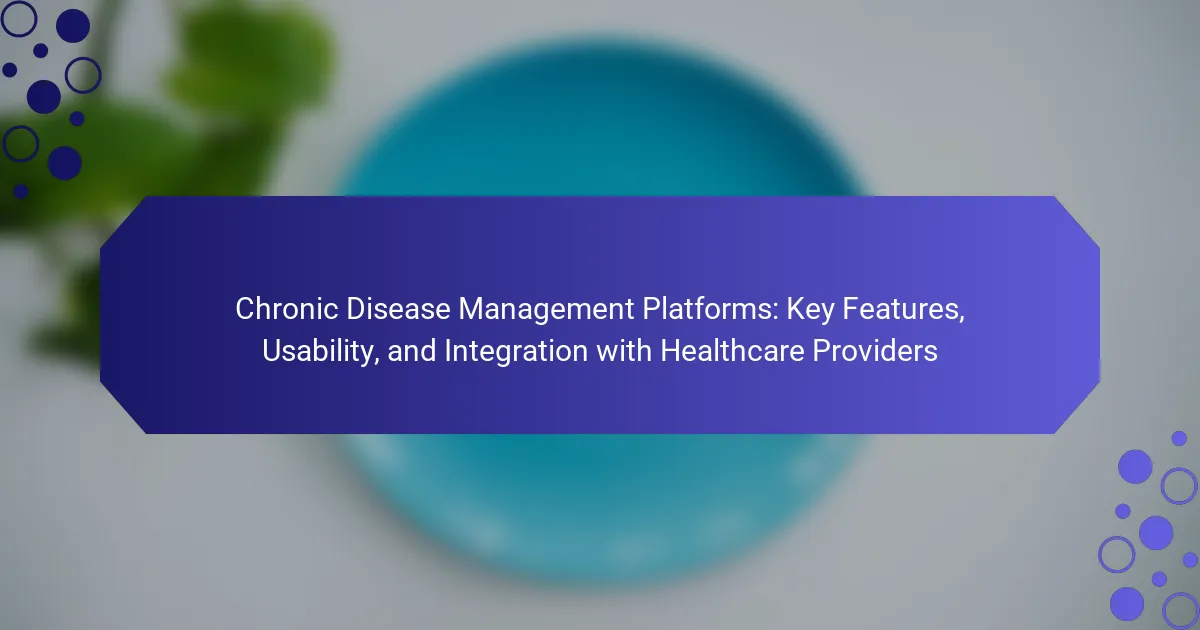Effective chronic disease management platforms improve patient outcomes through comprehensive data tracking and personalized care plans. Key features include user-friendly interfaces and seamless integration with healthcare providers. This article explores usability, integration capabilities, and best practices for enhancing these platforms. Understanding these elements is crucial for optimizing care for patients with chronic conditions.

What are the key features of chronic disease management platforms?
Chronic disease management platforms feature comprehensive data tracking, personalized care plans, and seamless integration with healthcare providers. These platforms enhance patient engagement through user-friendly interfaces and remote monitoring capabilities. They often include analytics tools for healthcare professionals to assess treatment efficacy and adjust strategies accordingly. Additionally, interoperability with electronic health records ensures continuity of care and improved health outcomes.
How do data analytics enhance chronic disease management?
Data analytics significantly enhance chronic disease management by providing actionable insights for personalized care. They enable healthcare providers to track patient data, identify trends, and optimize treatment plans. Enhanced data integration facilitates real-time monitoring of patient outcomes and adherence to therapies. As a result, patients receive tailored interventions, improving their overall health and quality of life.
What role does patient engagement play in these platforms?
Patient engagement is crucial in chronic disease management platforms as it enhances adherence and improves health outcomes. Engaged patients actively participate in their care, leading to better self-management and communication with healthcare providers. This interaction fosters a sense of ownership over their health, which can result in increased satisfaction and reduced hospitalizations. Platforms that incorporate features for tracking, reminders, and educational resources further enhance patient involvement, making chronic disease management more effective.
Which communication tools are most effective for healthcare providers?
Chronic disease management platforms that integrate effectively with healthcare providers include telehealth capabilities, patient engagement tools, and data analytics features. These tools enhance communication, improve patient outcomes, and streamline workflows. Key features such as user-friendly interfaces and interoperability with electronic health records are essential for usability. Integration with existing systems ensures seamless information sharing, which is critical for patient-centered care.
How do chronic disease management platforms ensure data security?
Chronic disease management platforms ensure data security through encryption, access controls, and compliance with regulations. These features protect sensitive patient information from unauthorized access and breaches. Regular security audits and updates further enhance data protection, ensuring platforms remain resilient against evolving threats.

How user-friendly are chronic disease management platforms?
Chronic disease management platforms are generally user-friendly, designed to enhance patient engagement and streamline healthcare processes. They often feature intuitive interfaces, personalized dashboards, and easy navigation, which facilitate user interaction. Integration with healthcare providers is seamless, allowing real-time data sharing and communication. These platforms prioritize usability, which is critical for patients managing complex conditions. User feedback often highlights the effectiveness of mobile accessibility and reminders in improving adherence to treatment plans.
What design principles improve usability for patients?
Design principles that improve usability for patients include simplicity, consistency, and accessibility. These principles ensure that chronic disease management platforms are intuitive and easy to navigate. Simplicity reduces cognitive load, allowing patients to focus on their health. Consistency in design elements enhances familiarity, making it easier for patients to use the platform effectively. Accessibility ensures that all patients, regardless of ability, can engage with the platform, promoting inclusive health management.
How do accessibility features cater to diverse user needs?
Accessibility features in chronic disease management platforms ensure all users can effectively engage with the technology. These features include customizable interfaces, screen readers, and voice commands, catering to varied needs like visual impairments and mobility challenges.
Platforms often integrate user feedback to enhance usability, ensuring features align with diverse requirements. For example, color contrast adjustments help visually impaired users, while simplified navigation supports those with cognitive challenges.
These adaptations not only improve individual user experiences but also promote adherence to treatment plans. Enhanced accessibility can lead to better health outcomes, as users feel empowered to manage their conditions more effectively.
What feedback mechanisms are essential for user experience improvement?
Effective feedback mechanisms for user experience improvement in chronic disease management platforms include user surveys, usability testing, analytics tracking, and direct provider feedback. User surveys gather insights on satisfaction and areas for enhancement. Usability testing identifies pain points during interactions. Analytics tracking reveals user behavior trends, while direct provider feedback ensures alignment with healthcare needs. These mechanisms collectively enhance platform usability and integration with healthcare providers, leading to better patient outcomes.

How do chronic disease management platforms integrate with healthcare providers?
Chronic disease management platforms integrate with healthcare providers through data sharing, interoperability, and communication tools. These platforms enable seamless exchange of patient information, enhancing care coordination and improving health outcomes. They often feature APIs for integration, allowing providers to access real-time data and analytics. This integration supports personalized treatment plans and facilitates remote monitoring, which is crucial for chronic disease management. Additionally, platforms may include patient engagement tools to encourage adherence to treatment protocols.
What are the challenges of interoperability with existing healthcare systems?
Interoperability challenges with existing healthcare systems include data silos, varying standards, and integration complexity. These issues hinder chronic disease management platforms from effectively sharing critical patient information. For example, disparate systems may use different data formats, complicating seamless communication. Additionally, regulatory compliance and security concerns further complicate integration efforts. These barriers can lead to inefficiencies, delayed care, and increased healthcare costs.
How do these platforms facilitate care coordination among providers?
Chronic disease management platforms enhance care coordination among providers by facilitating seamless communication and data sharing. These platforms enable real-time updates on patient conditions, streamline referrals, and consolidate treatment plans. As a result, healthcare teams can collaborate more effectively, improving patient outcomes and reducing redundancies. Integration with electronic health records (EHR) further supports interoperability, ensuring all providers access the same information.
Which data exchange standards are commonly used?
Common data exchange standards in chronic disease management platforms include HL7, FHIR, and CCD. These standards facilitate interoperability between healthcare providers and enhance data sharing capabilities. HL7 provides a framework for data exchange, while FHIR offers a modern approach using web technologies. CCD enables the sharing of patient summaries, improving care coordination.

What unique attributes differentiate various chronic disease management platforms?
Chronic disease management platforms differ in unique attributes such as personalized care plans, integration capabilities, user interface design, data analytics features, and patient engagement tools. These factors significantly impact usability and effectiveness. For instance, some platforms offer real-time data integration with electronic health records, while others focus on mobile accessibility and user-friendly interfaces.
How do specific platforms cater to particular chronic conditions?
Chronic disease management platforms cater to specific chronic conditions through tailored features and integrations. These platforms often include condition-specific monitoring tools, educational resources, and personalized care plans. For example, diabetes management platforms may offer glucose tracking and dietary guidance, while asthma platforms focus on inhaler adherence and environmental triggers. Integration with healthcare providers ensures real-time data sharing, enhancing patient engagement and treatment outcomes.
What innovative technologies are being incorporated into these platforms?
Chronic disease management platforms are incorporating innovative technologies such as artificial intelligence, telehealth integration, wearable devices, and data analytics. These advancements enhance patient monitoring, improve communication with healthcare providers, and personalize treatment plans. For instance, AI algorithms can analyze patient data to predict health deterioration, while wearables track real-time health metrics. As a result, these technologies significantly improve patient outcomes and streamline healthcare processes.

What are the main limitations of current chronic disease management platforms?
Current chronic disease management platforms face significant limitations. These include insufficient integration with healthcare providers, leading to fragmented patient data. Many platforms lack user-friendly interfaces, which can hinder patient engagement. Additionally, limited customization options restrict the ability to tailor care plans to individual needs. Finally, data security concerns can deter both patients and providers from fully utilizing these platforms.
How do cost factors affect platform adoption and usage?
Cost factors significantly influence platform adoption and usage by affecting accessibility and perceived value. High costs can deter users, while affordable options encourage wider adoption. Additionally, platforms that demonstrate cost-effectiveness through improved health outcomes gain traction. Integrating cost transparency enhances user trust and satisfaction, further promoting usage.
What are common technical issues users face?
Common technical issues users face with chronic disease management platforms include connectivity problems, data synchronization errors, user interface challenges, and integration difficulties with healthcare providers. These issues can hinder effective communication and data sharing, impacting overall patient care. Addressing these problems is vital for enhancing usability and ensuring seamless integration.

What best practices can enhance the effectiveness of chronic disease management platforms?
Implementing best practices enhances chronic disease management platforms by improving user engagement and outcomes. Key practices include user-friendly interfaces, personalized care plans, seamless integration with healthcare providers, and data security measures.
1. User-Friendly Interfaces: Intuitive design increases user adoption and satisfaction.
2. Personalized Care Plans: Tailored strategies lead to better patient adherence and health outcomes.
3. Seamless Integration: Connecting with healthcare providers ensures comprehensive care and real-time data sharing.
4. Data Security Measures: Protecting patient information builds trust and compliance with regulations.
These practices collectively enhance the effectiveness of chronic disease management platforms.
How can healthcare providers optimize their use of these platforms?
Healthcare providers can optimize their use of chronic disease management platforms by focusing on user-friendly design, seamless integration with existing systems, and leveraging data analytics. Prioritizing training for staff enhances usability and patient engagement. Regular feedback loops with users can identify areas for improvement. Additionally, ensuring compliance with health regulations fosters trust and security.
What strategies can improve patient adherence to management plans?
Implementing personalized communication, leveraging technology, and providing education can significantly enhance patient adherence to management plans. Personalized reminders via chronic disease management platforms foster engagement. User-friendly interfaces improve usability, encouraging regular interaction. Integration with healthcare providers ensures timely support and accountability, which are crucial for adherence.
